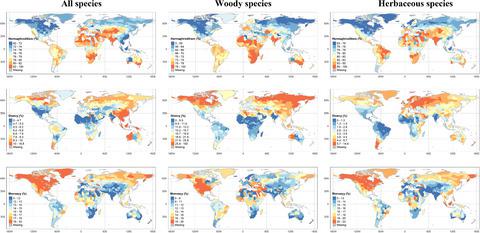当前位置:
X-MOL 学术
›
Ecol. Lett.
›
论文详情
Our official English website, www.x-mol.net, welcomes your
feedback! (Note: you will need to create a separate account there.)
Global distribution and evolutionary transitions of angiosperm sexual systems
Ecology Letters ( IF 7.6 ) Pub Date : 2021-06-14 , DOI: 10.1111/ele.13815 Yunyun Wang 1, 2 , Ao Luo 2 , Tong Lyu 2 , Dimitar Dimitrov 3 , Xiaoting Xu 4 , Robert P Freckleton 5 , Yaoqi Li 2 , Xiangyan Su 2 , Yichao Li 2 , Yunpeng Liu 2 , Denis Sandanov 6 , Qingjun Li 7 , Zhanqing Hao 8 , Shuguang Liu 1 , Zhiheng Wang 2
Ecology Letters ( IF 7.6 ) Pub Date : 2021-06-14 , DOI: 10.1111/ele.13815 Yunyun Wang 1, 2 , Ao Luo 2 , Tong Lyu 2 , Dimitar Dimitrov 3 , Xiaoting Xu 4 , Robert P Freckleton 5 , Yaoqi Li 2 , Xiangyan Su 2 , Yichao Li 2 , Yunpeng Liu 2 , Denis Sandanov 6 , Qingjun Li 7 , Zhanqing Hao 8 , Shuguang Liu 1 , Zhiheng Wang 2
Affiliation

|
Angiosperm sexual systems are fundamental to the evolution and distribution of plant diversity, yet spatiotemporal patterns in angiosperm sexual systems and their drivers remain poorly known. Using data on sexual systems and distributions of 68453 angiosperm species, we present the first global maps of sexual system frequencies and evaluate sexual system evolution during the Cenozoic. Frequencies of dioecy and monoecy increase with latitude, while hermaphrodites are more frequent in warm and arid regions. Transitions to dioecy from other states were higher than to hermaphroditism, but transitions away from dioecy increased since the Cenozoic, suggesting that dioecy is not an evolutionary end point. Transitions between hermaphroditism and dioecy increased, while transitions to monoecy decreased with paleo-temperature when paleo-temperature >0℃. Our study demonstrates the biogeography of angiosperm sexual systems from a macroecological perspective, and enhances our understanding of plant diversity patterns and their response to climate change.
中文翻译:

被子植物有性系统的全球分布和进化转变
被子植物性系统是植物多样性进化和分布的基础,但被子植物性系统的时空模式及其驱动因素仍然知之甚少。使用关于 68453 种被子植物的性系统和分布的数据,我们展示了第一个性系统频率的全球地图,并评估了新生代的性系统进化。雌雄异株和雌雄同株的频率随纬度增加而增加,而雌雄同体在温暖和干旱地区更常见。从其他状态向雌雄同体的过渡高于雌雄同体,但自新生代以来,从雌雄异体的过渡增加,表明雌雄异株不是进化的终点。当古温度>0℃时,雌雄同体和雌雄同体的转变增加,而随着古温度的升高,雌雄同体向雌雄同体的转变减少。
更新日期:2021-08-10
中文翻译:

被子植物有性系统的全球分布和进化转变
被子植物性系统是植物多样性进化和分布的基础,但被子植物性系统的时空模式及其驱动因素仍然知之甚少。使用关于 68453 种被子植物的性系统和分布的数据,我们展示了第一个性系统频率的全球地图,并评估了新生代的性系统进化。雌雄异株和雌雄同株的频率随纬度增加而增加,而雌雄同体在温暖和干旱地区更常见。从其他状态向雌雄同体的过渡高于雌雄同体,但自新生代以来,从雌雄异体的过渡增加,表明雌雄异株不是进化的终点。当古温度>0℃时,雌雄同体和雌雄同体的转变增加,而随着古温度的升高,雌雄同体向雌雄同体的转变减少。











































 京公网安备 11010802027423号
京公网安备 11010802027423号